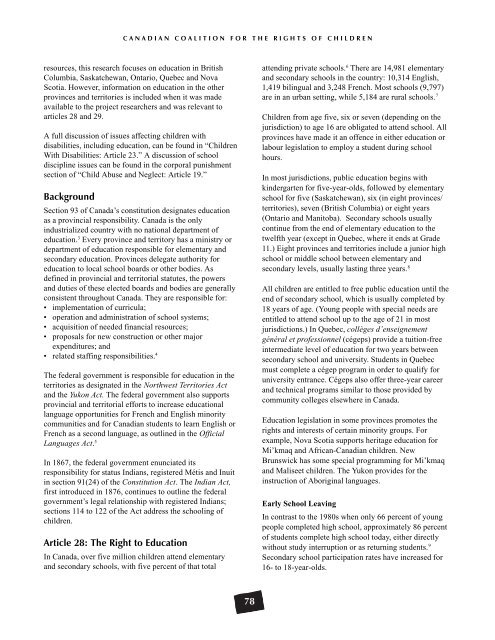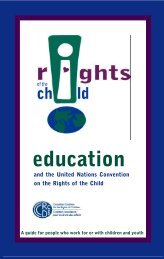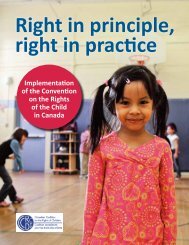Poste - Canadian Coalition for the Rights of Children
Poste - Canadian Coalition for the Rights of Children
Poste - Canadian Coalition for the Rights of Children
You also want an ePaper? Increase the reach of your titles
YUMPU automatically turns print PDFs into web optimized ePapers that Google loves.
C A N A D I A N C O A L I T I O N F O R T H E R I G H T S O F C H I L D R E N<br />
resources, this research focuses on education in British<br />
Columbia, Saskatchewan, Ontario, Quebec and Nova<br />
Scotia. However, in<strong>for</strong>mation on education in <strong>the</strong> o<strong>the</strong>r<br />
provinces and territories is included when it was made<br />
available to <strong>the</strong> project researchers and was relevant to<br />
articles 28 and 29.<br />
A full discussion <strong>of</strong> issues affecting children with<br />
disabilities, including education, can be found in “<strong>Children</strong><br />
With Disabilities: Article 23.” A discussion <strong>of</strong> school<br />
discipline issues can be found in <strong>the</strong> corporal punishment<br />
section <strong>of</strong> “Child Abuse and Neglect: Article 19.”<br />
Background<br />
Section 93 <strong>of</strong> Canada’s constitution designates education<br />
as a provincial responsibility. Canada is <strong>the</strong> only<br />
industrialized country with no national department <strong>of</strong><br />
education. 3 Every province and territory has a ministry or<br />
department <strong>of</strong> education responsible <strong>for</strong> elementary and<br />
secondary education. Provinces delegate authority <strong>for</strong><br />
education to local school boards or o<strong>the</strong>r bodies. As<br />
defined in provincial and territorial statutes, <strong>the</strong> powers<br />
and duties <strong>of</strong> <strong>the</strong>se elected boards and bodies are generally<br />
consistent throughout Canada. They are responsible <strong>for</strong>:<br />
• implementation <strong>of</strong> curricula;<br />
• operation and administration <strong>of</strong> school systems;<br />
• acquisition <strong>of</strong> needed financial resources;<br />
• proposals <strong>for</strong> new construction or o<strong>the</strong>r major<br />
expenditures; and<br />
• related staffing responsibilities. 4<br />
The federal government is responsible <strong>for</strong> education in <strong>the</strong><br />
territories as designated in <strong>the</strong> Northwest Territories Act<br />
and <strong>the</strong> Yukon Act. The federal government also supports<br />
provincial and territorial ef<strong>for</strong>ts to increase educational<br />
language opportunities <strong>for</strong> French and English minority<br />
communities and <strong>for</strong> <strong>Canadian</strong> students to learn English or<br />
French as a second language, as outlined in <strong>the</strong> Official<br />
Languages Act. 5<br />
In 1867, <strong>the</strong> federal government enunciated its<br />
responsibility <strong>for</strong> status Indians, registered Métis and Inuit<br />
in section 91(24) <strong>of</strong> <strong>the</strong> Constitution Act. The Indian Act,<br />
first introduced in 1876, continues to outline <strong>the</strong> federal<br />
government’s legal relationship with registered Indians;<br />
sections 114 to 122 <strong>of</strong> <strong>the</strong> Act address <strong>the</strong> schooling <strong>of</strong><br />
children.<br />
Article 28: The Right to Education<br />
In Canada, over five million children attend elementary<br />
and secondary schools, with five percent <strong>of</strong> that total<br />
78<br />
attending private schools. 6 There are 14,981 elementary<br />
and secondary schools in <strong>the</strong> country: 10,314 English,<br />
1,419 bilingual and 3,248 French. Most schools (9,797)<br />
are in an urban setting, while 5,184 are rural schools. 7<br />
<strong>Children</strong> from age five, six or seven (depending on <strong>the</strong><br />
jurisdiction) to age 16 are obligated to attend school. All<br />
provinces have made it an <strong>of</strong>fence in ei<strong>the</strong>r education or<br />
labour legislation to employ a student during school<br />
hours.<br />
In most jurisdictions, public education begins with<br />
kindergarten <strong>for</strong> five-year-olds, followed by elementary<br />
school <strong>for</strong> five (Saskatchewan), six (in eight provinces/<br />
territories), seven (British Columbia) or eight years<br />
(Ontario and Manitoba). Secondary schools usually<br />
continue from <strong>the</strong> end <strong>of</strong> elementary education to <strong>the</strong><br />
twelfth year (except in Quebec, where it ends at Grade<br />
11.) Eight provinces and territories include a junior high<br />
school or middle school between elementary and<br />
secondary levels, usually lasting three years. 8<br />
All children are entitled to free public education until <strong>the</strong><br />
end <strong>of</strong> secondary school, which is usually completed by<br />
18 years <strong>of</strong> age. (Young people with special needs are<br />
entitled to attend school up to <strong>the</strong> age <strong>of</strong> 21 in most<br />
jurisdictions.) In Quebec, collèges d’enseignement<br />
général et pr<strong>of</strong>essionnel (cégeps) provide a tuition-free<br />
intermediate level <strong>of</strong> education <strong>for</strong> two years between<br />
secondary school and university. Students in Quebec<br />
must complete a cégep program in order to qualify <strong>for</strong><br />
university entrance. Cégeps also <strong>of</strong>fer three-year career<br />
and technical programs similar to those provided by<br />
community colleges elsewhere in Canada.<br />
Education legislation in some provinces promotes <strong>the</strong><br />
rights and interests <strong>of</strong> certain minority groups. For<br />
example, Nova Scotia supports heritage education <strong>for</strong><br />
Mi’kmaq and African-<strong>Canadian</strong> children. New<br />
Brunswick has some special programming <strong>for</strong> Mi’kmaq<br />
and Maliseet children. The Yukon provides <strong>for</strong> <strong>the</strong><br />
instruction <strong>of</strong> Aboriginal languages.<br />
Early School Leaving<br />
In contrast to <strong>the</strong> 1980s when only 66 percent <strong>of</strong> young<br />
people completed high school, approximately 86 percent<br />
<strong>of</strong> students complete high school today, ei<strong>the</strong>r directly<br />
without study interruption or as returning students. 9<br />
Secondary school participation rates have increased <strong>for</strong><br />
16- to 18-year-olds.




